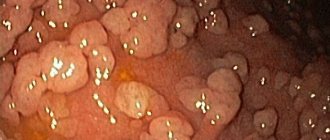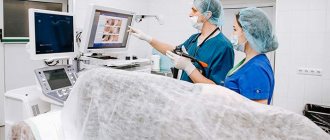What is pylorospasm and the main causes of pathology
Gastric pylorospasm in adults is a pathological condition in which spasm of the pylorus is observed. According to the International Classification of Diseases, pylorospasm is a pathology of the digestive tract. The ICD-10 code for pylorospasm is K 31.3.
The main etiological factor of pylorospasm is a violation in the functionality of the neuromuscular system, which causes, depending on the causes of occurrence, pylorospasm is divided into 2 types: primary and secondary.
Primary pylorospasm occurs in the presence of the following irritants:
- dysfunction of the nervous system;
- increased physical or intellectual stress;
- dysfunction of the autonomic nervous system;
- lack of vitamin B;
- poisoning with toxic substances (morphine, nicotine).
Secondary pylorospasm usually occurs due to the following factors:
- chronic gastritis,
- stomach ulcers,
- formation of adhesions,
- Crohn's disease;
- disturbances in the functionality of the gallbladder,
- pathologies of the pelvic organs,
- polyposis of the stomach.
How to treat pylorospasm and what it is. Symptoms and diagnosis of pylorospasm in adults
Pylorospasm is usually called a disorder of the neuromuscular apparatus of the pyloric part of the stomach. Most often it is functional in nature. The pyloric zone itself is located directly at the junction of the stomach and the duodenum. Pylorospasm can be primary or secondary.
The pyloric section of the stomach is its thinnest part. It is located at the junction of the stomach and intestines. It is in this place that the largest number of compressor muscles are located.
When there are disturbances in muscle function, they spasm. In this regard, the passage of food is also difficult. Because of this, all undigested food remains in the stomach, and pylorospasm occurs on this basis.
Primary pylorospasm can develop as a result of irritation of the pyloric receptor centers. In this case, it is the upper intestine that is severely irritated.
The reasons for the appearance of this condition can be considered:
- lack of vitamin B;
- constant mental stress;
- dysfunction of the regulatory functioning of the stomach;
- malfunctions of the autonomic system;
- severe intoxication of the body.
The causes of the secondary form of the disease in adults can be:
- peptic ulcer of the gastrointestinal tract (gastrointestinal tract);
- gastritis - both acute and chronic forms;
- pyloroduodenitis;
- stomach polyps;
- colitis and enterocolitis;
- Crohn's disease;
- inflammation of the appendix;
- diseases of the biliary tract;
- inflammation and adhesions that develop in the pelvis in women.
Symptoms, diagnosis and treatment of pyloric spasm in newborns and young infants
Often, the symptoms of this disease can be identified from the moment the child is born. In rare cases, diagnosis and treatment can take up to several months.
The main signs may not be noticed by parents at first, since newly born children often have problems with bloating, infrequent bowel movements, and colic.
Source: https://alkomir.net/kak-lechit-pilorospazm-i-chto-eto-takoe-simptomy-i-diagnostika-pilorospazma-u-vzroslyh/
Symptoms of the disease in adults
One of the main symptoms of pylorospasm in adults is vomiting. Vomiting occurs immediately after eating and can have varying intensity. Vomit has an unpleasant smell of rot. In addition, pylorospasm is manifested by other symptoms:
- decreased appetite;
- weakness and drowsiness;
- cramps and pain in the stomach;
- frequent attacks of nausea;
- unpleasant aftertaste in the mouth;
- belching, which has an unpleasant smell of rot;
- the presence of undigested food particles in the stool.
Despite the typicality of the symptoms of pyloric spasm in adults, you should not self-medicate, as this can lead to the development of negative consequences.
Signs and treatment of pylorospasm in adults and children
Pylorospasm is a dangerous pathology that, if not properly treated, can transform into pyloric stenosis. The clinical picture is similar to many other pathological conditions caused by diseases of the gastrointestinal tract. When complications occur, the pylorus is affected, requiring surgical intervention.
Etiology of pylorospasm in adults and children
Pylorostenosis and pylorospasm are two pathologies that accompany each other. Pylorospasm in children is manifested by functional disorders of the muscular-nervous apparatus of the stomach, namely its pylorus.
This zone is located in the area of the transition of the stomach to the duodenum.
Basically, pylorospasm is recorded in infants, schoolchildren and preschoolers; rarely, this disease is observed in adults.
The stomach has a pyloric section, which is the narrowest of all the others, as it passes into the intestine. It contains a large layer of constrictor muscles. If the tone of this muscle, which normally should contract continuously, is impaired, the passage of food becomes more difficult. With pylorospasm, there is retention of food in the stomach, as well as vomiting.
Pylorospasm in infants occurs due to dysfunction of the nervous autonomic system. Much less often, congenital pyloric stenosis, a defect that develops in the pyloric gastric region, becomes a provoking factor.
Pylorospasm in adults can be a consequence of peptic ulcer disease, chronic gastritis, diseases of the lower gastrointestinal tract and polyposis.
In addition, pathology can be provoked by some ailments of the biliary tract, prolonged adhesions and inflammatory processes that occur in the female pelvis.
As for the primary manifestation, pylorospasm occurs when the interoreceptors, which are located in the pyloric area, are irritated. This occurs against the background of stress, overwork and lack of vitamin B, irritable intestines, improper nervous regulation, intoxication with nicotine and morphine.
Features of pyloric stenosis
Congenital pyloric stenosis is a special defect in the development of the gastrointestinal tract, which is characterized by narrowing of the pylorus. Congenital pathology can appear in the second to fourth week of a newborn’s life. The main symptom is intense vomiting that occurs after feeding. The disease is also accompanied by oliguria, constipation and weight loss, and skin turgor is observed.
Ultrasound, endoscope and radiography of the stomach are used as diagnostics. Treatment of congenital pyloric stenosis involves emergency surgery, pyloromyotomy and subsequent physical therapy and diet.
This disease is not uncommon: 1 case of pathology is recorded per 300 children. This disease is four times more common in boys. Congenital disease is the most common pathology in surgery at this age stage, which requires emergency surgical intervention.
Do not forget about such a type of disease as hypertrophic pyloric stenosis. This disease should be separated from other forms of pyloric obstruction, namely, membrane stenosis, compression by strands and abnormal vessels, prolapse of the mucous membrane, and others.
Hypertrophic pyloric stenosis is subject to surgical intervention. Symptoms make themselves felt in the fourth to sixth week of the baby’s life. Quite rarely, primary hypertrophy occurs in other parts of the gastrointestinal tract: the esophagus, sphincter, small intestine, duodenum and ileum.
It is not difficult to detect signs of pyloric stenosis, since they manifest themselves clearly and intensely. The first manifestation usually occurs at 2-3 weeks of a child’s life. The disease develops rapidly.
The main signs of pyloric stenosis:
- retraction of the fontanel;
- intense, profuse vomiting in the form of a fountain;
- vomit has a sour smell;
- rapid weight loss;
- dehydration of the whole body;
- constipation, scanty and dry stools;
- a small amount of concentrated urine with a pungent odor and a bright yellow tint;
- loss of skin elasticity;
- coma.
A newborn is not able to go without feeding for a long time, so you need to urgently call an ambulance. Surgery is indicated. If left untreated, the disease can lead to complications.
Specifics of therapeutic therapy
For pyloric stenosis, treatment is surgical. Bougienage of the pyloric canal causes short-term opening and repeated stenosis.
Before the operation, it is necessary to prepare the baby by performing infusion therapy using protein, glucose-salt solutions, and antispasmodics.
In addition, it is imperative to compensate for the lack of nutrients and fluids with the help of microenemas.
Congenital pathology requires pyloromyotomy according to Frede-Ramsted.
This process involves dissecting the serous-muscular layer to the mucosa, removing anatomical obstacles, and restoring the natural patency of the canal. Methods of operation: open and transumbilical laparoscopy.
Pyloric stenosis and pylorospasm are dangerous pathological processes. It is very important to consult a doctor in a timely manner for surgical intervention. It is necessary to be attentive to the baby’s health condition and respond to all signs of illness.
Source: https://VashZhkt.com/bolezni/pilorospazm-u-vzroslyh.html
Differential diagnosis of the disease
Since the clinical picture of the disease is similar to many pathologies, differential diagnosis is required. With pylorospasm, the diagnostic criteria are somewhat different. Initially, the doctor interviews and examines the patient. The results of such an examination are not enough to make a diagnosis of pylorospasm.
As an additional examination, doctors prescribe laboratory testing of physiological fluids. This type of study is not particularly informative, since in the initial stages of pylorospasm, the indicators in the analyzes remain unchanged.
In complicated forms of pathology with pylorospasm, tests reveal: anemia, chloremia. Urine has a light color, with a low specific gravity. The main diagnostic methods for pylorospasm are instrumental examination.
Interview and examination of the patient
When interviewing a patient, the doctor clarifies whether the patient has chronic diseases. If there are no such pathologies, then it is important to establish when vomiting first appeared. In addition, it is important to clarify whether surgical interventions were performed in the abdominal cavity; this is necessary to exclude the development of adhesions.
After the survey, the specialist examines the patient. At the same time, he palpates the abdomen in the stomach area. In addition, the condition of the skin is assessed.
Instrumental methods
To clarify the diagnosis, the doctor may prescribe instrumental research methods (when identifying pylorospasm, they are considered the most effective):
1. X-ray examination of the stomach with the introduction of contrast liquid (barium sulfate). With the development of a mild form of pylorospasm, good patency of the sphincter is observed. Most of the contrast agent passes into the intestine. Pyloric spasms are usually minor. In more severe forms, patency is impaired and stagnation of the contrast agent is observed. 2. Fibroesogastroscopy. It involves inserting an endoscope into the stomach cavity (swallowing a light bulb). In the initial stages of pathology, the endoscope easily passes into the sphincter area, and there are no food debris. When the disease is advanced, patency is impaired and food stagnation is observed.
Differentiation from pyloric stenosis
To choose the right treatment, it is important to differentiate pylorospasm from pyloric stenosis. With pyloric stenosis, fountain vomiting is observed, and with pylorospasm, a small amount of rejected fluid is released. In addition, a characteristic feature of pyloric stenosis is the presence of constipation and rapid deterioration in health.
When differentially diagnosing pylorospasm from pyloric stenosis, patients are prescribed an X-ray examination. With pyloric stenosis, prolonged spasms of the pylorus are observed. The pathogenic area looks like a thin thread. At the same time, taking antispasmodics does not make the patient feel better.
Carrying out endoscopy for pyloric stenosis allows you to diagnose changes and hypertrophy of muscle tissue.
Diagnostics
Laboratory tests are important in diagnosis. Changes in the blood develop slowly, are recorded over significant periods of the disease, and are not specific and pronounced.
A general blood test reveals a decrease in hemoglobin, a biochemical test reveals a decrease in the content of total protein, electrolytes (sodium, potassium, chlorine), and alkalosis. There is an increased tendency to form blood clots due to blood thickening.
A clinical blood test can signal a problem in a child’s body even before the appearance of clear symptoms of the disease.
In addition, examinations are carried out:
- Fibrogastroduodenoscopy. Using an endoscope, the condition of the mucous membranes of the stomach, the initial parts of the intestine, and the presence of pyloric spasm are examined. Neoplasms are excluded. Often during the procedure, material is taken for a biopsy.
- X-ray examination using contrast agents. It is important to record the time of evacuation of contrast from the stomach and exclude an organic cause of the delay.
It is necessary to differentiate the pathology from intestinal colic in infants.
It is important in diagnosing the disease not to miss the presence of pyloric stenosis. These two similar diseases have a number of differences.
Differences between pylorospasm and pyloric stenosis - table
| Pylorospasm | Pyloric stenosis |
| functional disorder | organic disease |
| the time for evacuation of contrast from the stomach during x-ray is 3–6 hours | the contrast remains in the stomach for more than 6 hours |
| peristalsis is not visible, the abdomen is painless | hourglass symptom, painful lump in the right hypochondrium |
| nausea, regurgitation | vomiting profusely, like a fountain |
| sour smell of vomit | putrid smell |
| body weight decreases slightly | severe weight loss |
| amenable to conservative therapy | surgical treatment only |
| rare dehydration | frequent dehydration |
| stool is normal | constipation |
Video: pylorospasm and pyloric stenosis - what is the difference
Methods for treating pylorospasm
You should not self-medicate for pylorospasm, as this can lead to the development of negative consequences. It is better to seek medical help immediately. The doctor will examine the patient and decide how to treat pylorospasm.
Treatment of pyloric spasm involves the combined use of several therapeutic techniques. This is necessary in order to eliminate the factors that provoked the development of pathology. Treatment of pylorospasm is carried out using the following methods:
- diet therapy;
- drug therapy;
- treatment with folk remedies.
Diet therapy
The diet for pylorospasm in adults consists of excluding foods with a high fiber content.
These include vegetables and fruits. These products can be consumed only after heat treatment (boiled).
In addition, it is important that all food is thoroughly chopped.
Even soups should be pureed.
Dishes must be warm. Hot or cold foods are not allowed.
Medications
In addition to diet for pylorospasm, it is important to take medications. The following groups of medications are most often prescribed:
- myotropic antispasmodics - these drugs have a vasodilator and antispasmodic effect. Most often, Drotaverine, No-shpa or Papaverine are prescribed;
- antihistamines - usually prescribed Promethazion;
- sedatives - have a calming effect, thereby stopping increased nervous excitability. Usually a tincture of motherwort or valerian is used;
- nootropic - reduce the excitability of nerve endings and reduce the tone of muscle tissue. Phenibut is usually prescribed.
Treatment of pylorospasm with traditional methods
In order to increase the effectiveness of the treatment, the doctor may prescribe the use of traditional medicine. As monotherapy, they are practically useless, but in combination with taking medications, they give excellent results.
- Take an infusion of valerian or motherwort. These herbs have a calming effect and prevent the occurrence of mental problems.
- To reduce the intensity of pain, you can take belladonna tincture. It is recommended to use 5 drops of the product three times a day.
- To ease general well-being , ozokerite or paraffin applications are recommended. The compress with the medicine must be placed on the stomach.
Pylorospasm in adults: symptoms and treatment of pylorospasm, what it is, how to treat it
Today, such a phenomenon as pylorospasm in adults is not so rare. Although most often this disease occurs in infants and preschool children. However, pylorospasm is often diagnosed in people after 25-30 years of age. Pylorospasm in an adult is a type of regional gastric spasm. What is this phenomenon connected with?
What is pylorospasm and the main causes of the disease
Pylorospasm is usually called a disorder of the neuromuscular apparatus of the pyloric part of the stomach. Most often it is functional in nature. The pyloric zone itself is located directly at the junction of the stomach and the duodenum. Pylorospasm can be primary or secondary.
The pyloric section of the stomach is its thinnest part. It is located at the junction of the stomach and intestines. It is in this place that the largest number of compressor muscles are located.
When there are disturbances in muscle function, they spasm. In this regard, the passage of food is also difficult. Because of this, all undigested food remains in the stomach, and pylorospasm occurs on this basis.
Primary pylorospasm can develop as a result of irritation of the pyloric receptor centers. In this case, it is the upper intestine that is severely irritated.
The reasons for the appearance of this condition can be considered:
- lack of vitamin B;
- constant mental stress;
- dysfunction of the regulatory functioning of the stomach;
- malfunctions of the autonomic system;
- severe intoxication of the body.
The causes of the secondary form of the disease in adults can be:
- peptic ulcer of the gastrointestinal tract (gastrointestinal tract);
- gastritis - both acute and chronic forms;
- pyloroduodenitis;
- stomach polyps;
- colitis and enterocolitis;
- Crohn's disease;
- inflammation of the appendix;
- diseases of the biliary tract;
- inflammation and adhesions that develop in the pelvis in women.
Manifestations of the disease
Pylorospasm is considered a rather specific disease. As it develops, pain appears directly in the epigastric part. Most often it is colic in nature, so diagnostics are indispensable.
Some doctors, making diagnoses without a thorough examination, come to the conclusion that this patient’s condition may be caused by developing gallstone disease:
- However, you should pay attention to the fact that with pylorospasm a person rapidly loses weight, but if there are stones in the bile ducts, patients, on the contrary, gain excess weight.
- Attacks of pyloric spasm are almost never accompanied by an increase in body temperature, while cholelithiasis always occurs against a background of high temperature during attacks.
After the attack of pyloric spasm passes, the patient begins to spontaneously urinate profusely. At the same time, the urine is quite light in color, with a low specific gravity.
The most common symptoms of pylorospasm are severe nausea and pain in the epigastric region.
Vomiting in adults is observed only in the most severe cases, which leads to severe dehydration. A large amount of chloride compounds and water comes out of a person. Thus, we can talk about the development of symptoms such as alkalosis or chloropenia. Vomiting most often comes out like a fountain.
This can only be explained by hypersecretion of the stomach, during which profuse vomit appears. If food has been in the stomach for a long time, the vomit will have a rather unpleasant, in some cases even putrefactive, odor.
This patient condition is sometimes called pyloric stenosis.
Symptoms of pyloric stenosis:
- excessive vomiting;
- a sharp decrease in the patient’s body weight;
- vomiting with a putrid odor;
- contractions of the pylorus are very similar to stomach cramps;
- the pylorus can be felt as a small tumor.
Mechanisms for treating pylorospasm
Treatment of pylorospasm in adults is based on both diet therapy and the use of medications.
First of all, the cause that could provoke the attack should be eliminated. In this case, it is necessary to establish the correct daily and sleep schedule.
The diet should be as gentle as possible. Consumption of foods rich in fiber is contraindicated. All spicy foods and seasonings should be excluded from the diet. The food should be liquid or well ground.
It is recommended to eat as much fat as possible, that is, include a lot of:
The food should be slightly warmed up. Eating too hot or cold foods is strictly prohibited.
During pyloric stenosis, the surgical method of therapy is most often used. To normalize the water-salt balance, Ringer's solution is infused subcutaneously, as well as a 0.85% sodium chloride solution.
A 10% sodium chloride solution is administered intravenously. A fairly effective method of treatment is daily intravenous infusions of glucose, sodium chloride and potassium chloride.
In order to remove excess sugar from the body, sometimes an insulin ampoule is also added to such solutions.
Treatment of pylorospasm with traditional methods
Since pylorospasm can be accompanied by many symptoms, we are talking not only about disturbances in the functioning of the stomach. Some other organs are also affected.
To eliminate the main symptoms of the disease, you can resort to folk remedies:
- A fairly common symptom of pylorospasm is mental disorders. The person becomes too irritable and hot-tempered. In this case, herbs are used that have a calming effect on the body. These include valerian, motherwort and hawthorn.
- To reduce pain and nausea, as well as to reduce pyloric hypertonicity, it is recommended to take belladonna tincture 5 drops 3 times a day.
- To improve the general well-being of the patient, thermal procedures are used. Ozokerite and paraffin applications are made on the abdominal cavity, and warm compresses are applied.
- Physical therapy and massage have a good healing effect.
In any case, if a person refuses drug treatment, he can use some traditional medicine methods. However, even in this case, it is worth remembering that no medicine, even the most harmless (at first glance), should be taken without consulting a doctor.
If the doctor approves the herbal treatment regimen, then they can be used, but only in strictly defined quantities. After all, even medicinal herbs, if they enter the patient’s body in excess quantities, can cause harm to the body.
That is, if the patient wants to alleviate his condition, and not aggravate it, then any medicinal decoctions should be taken according to a regimen clearly defined by the doctor.
General recommendations
Although pyloric spasms are most common in children, this condition can also be observed repeatedly in adults. That is why, when the first alarming symptoms appear, you should not self-medicate, but it is better to immediately seek advice from a specialist.
He must conduct a thorough diagnostic examination to accurately determine the reason why the patient is in this condition:
- Only after determining the exact cause of the appearance of such symptoms can the doctor make a final diagnosis of “pylorospasm” and prescribe the most adequate treatment in this case.
- If drug treatment does not bring the desired results, then we can talk about pyloric stenosis in the patient. This diagnosis in most cases requires only surgical intervention.
Outpatient treatment should not only consist of taking medications and medicinal herbs, it also involves following a strict diet. Without following this rule, treatment will have virtually no results.
Therefore, if the patient wants to alleviate his condition and put the disease into remission, then he should strictly follow all the doctor’s recommendations regarding the prescribed diet. After all, in this case there is no way to do without a proper diet.
Because in this situation it is necessary to eliminate spastic phenomena, and irritating food cannot contribute to this in any way. If a person is treated correctly, the symptoms of the disease will soon disappear.
Source: https://zheludoc.ru/boli/pilorospazm-u-vzroslyh.html
General preventive recommendations
There are several recommendations that will help avoid the development of pylorospasm in the adult population:
- eliminate bad habits (smoking, drinking alcohol and drugs);
- normalize your daily routine. A person should sleep at least 8 hours per day;
- Avoid eating fried and fatty foods to reduce the load on the digestive tract.
If treatment for pyloric spasm was started in a timely manner, then the chance of avoiding negative consequences is 95%. Therefore, it is important to immediately consult a doctor at the first symptoms of pathology.








